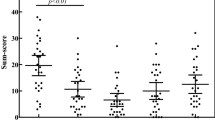Abstract.
Objective and Design: Histamine in food has been shown to induce intolerance reactions mimicking food allergy. These reactions seem to be due to impaired histamine metabolism caused by reduced diamine oxidase activity. To validate routine serum diamine oxidase assessment, daily variations of diamine oxidase were evaluated.¶Methods: Blood was drawn from each of 20 healthy volunteers (10 female, 10 male; mean age 32.5 years) every 2 h from 9 a.m. to 5 p.m., and diamine oxidase activity was measured using the C14 putrescine method. To assess possible influences of H1 and H2 blockers on diamine oxidase activity, diphenhydramine, ketotifen, cimetidine, and ranitidine were incubated at pharmacologic concentrations with human placental diamine oxidase (identical to neutrophilic and eosinophilic diamine oxidase). Inhibition of diamine oxidase activity was calculated as the percentage of inhibition versus control. In addition, the known diamine oxidase inhibitors, dihydralazine and aminoguanidine, were used as positive controls.¶Results: Serum diamine oxidase levels showed no significant daily variations (0.041 ± 0.025; 0.037 ± 0.022; 0.041 ± 0.023; 0.040 ± 0.023; 0.038 ± 0.025 nKat/l) and no significant sex differences (female 0.040 ± 0.028 nKat/l versus male 0.039 ± 0.019 nKat/l). Antihistamines had no influence on diamine oxidase activity except for cimetidine, which caused 25% inhibition at the highest dose tested (p < 0.0002) (positive control: aminoguanidine 85% inhibition (p < 0.0001), dihydralazine 68% inhibition (p < 0.0001)) and diphenhydramine, which caused 19% increase (p < 0.0001) of enzyme activity.¶Conclusion: Serum diamine oxidase levels do not show daily variations allowing assessment anytime during office hours. However, diagnostic interpretation of serum diamine oxidase levels may be difficult.
Similar content being viewed by others
Author information
Authors and Affiliations
Additional information
Received 27 April 1998; accepted by E. Neugebauer 8 July 1998
Rights and permissions
About this article
Cite this article
Wantke, F., Proud, D., Siekierski, E. et al. Daily variations of serum diamine oxidase and the influence of H1 and H2 blockers: A critical approach to routine diamine oxidase assessment. Inflamm. res. 47, 396–400 (1998). https://doi.org/10.1007/s000110050350
Issue Date:
DOI: https://doi.org/10.1007/s000110050350




